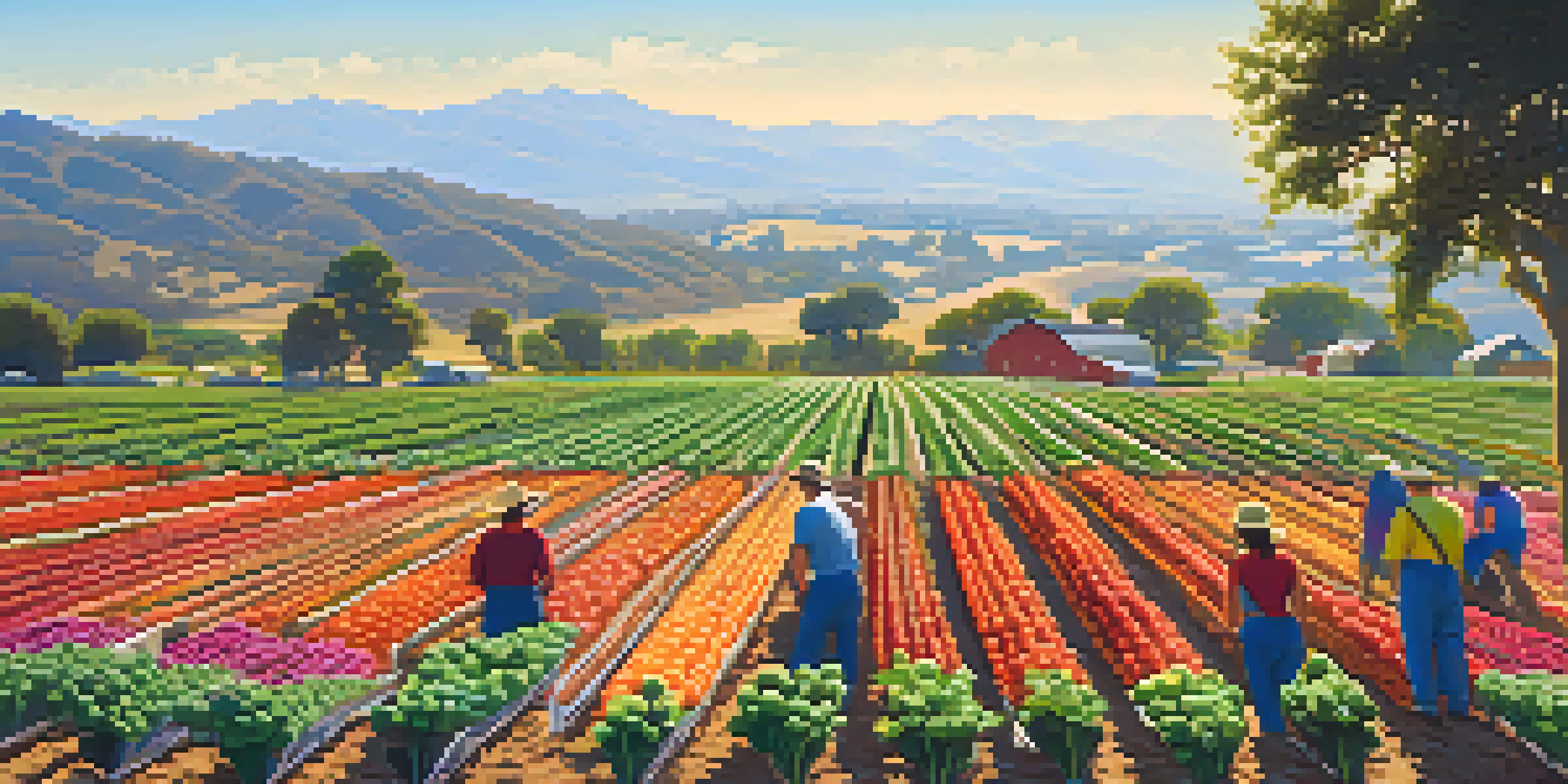California's Organic Farming Movement: Growth and Challenges

The Rise of Organic Farming in California
California has become a beacon for organic farming, leading the nation in both the number of organic farms and the acreage dedicated to organic practices. This growth reflects a broader shift in consumer preferences toward healthier, sustainably produced food. The organic farming movement gained significant traction in the 1960s and 70s, driven by the counterculture's desire for natural products.
Organic farming is not a new fad; it is a return to a sustainable way of farming that respects nature and the environment.
Today, California's organic farms span diverse sectors, including fruits, vegetables, and livestock, showcasing the state's rich agricultural landscape. With approximately 4,000 certified organic farms, California accounts for nearly half of all organic produce sold in the United States. This remarkable achievement highlights the state's commitment to environmentally friendly farming practices.
However, this rapid expansion comes with its own set of challenges. Farmers must navigate fluctuating consumer demand, the complexities of organic certification, and competition from conventional farming. Balancing these factors while maintaining high-quality produce is key to sustaining growth in California's organic farming sector.
Key Benefits of Organic Farming
Organic farming offers a plethora of benefits, not just for farmers but also for consumers and the environment. By avoiding synthetic pesticides and fertilizers, organic farmers promote healthier soil and ecosystems. This practice leads to increased biodiversity, reduced pollution, and improved water conservation compared to conventional farming methods.

For consumers, organic produce often translates to fresher and tastier options. Many people believe that organic foods are more nutritious, although research on this topic is still ongoing. Furthermore, buying organic supports local economies and fosters a connection between consumers and their food sources, creating a sense of community.
California Leads Organic Farming
California is at the forefront of organic farming in the U.S., with around 4,000 certified farms and a significant share of the national organic produce market.
The health implications are also significant. Eating organic is associated with lower exposure to harmful chemicals, which is particularly crucial for vulnerable populations, such as children and pregnant women. As awareness of these health benefits grows, so too does the demand for organic products, pushing farmers to adapt and expand.
Challenges Faced by Organic Farmers
Despite the numerous benefits, organic farmers in California face substantial challenges that can hinder their success. One major concern is the cost of organic certification, which can be prohibitively expensive, especially for small-scale farmers. These costs include not only the application fees but also the investments required to comply with organic standards.
The future of agriculture is about innovation, sustainability, and connecting with our local communities.
Additionally, organic farmers often deal with pest management issues without the safety net of synthetic pesticides. This can lead to crop losses and lower yields, impacting profitability. The reliance on natural methods like crop rotation and beneficial insects often requires more time and labor, which can be a strain on resources.
Furthermore, the organic market is highly competitive, with increasing numbers of farms entering the space. Farmers must constantly innovate and improve their practices to stay relevant and appealing to consumers. This ongoing pressure can lead to stress and burnout among farmers, making it essential to find a balance between passion and practicality.
The Role of Technology in Organic Farming
Technology has become a game-changer for organic farmers, providing innovative solutions to traditional farming challenges. Precision agriculture, for instance, allows farmers to monitor crop health and soil conditions more accurately than ever before. This data-driven approach helps optimize resource use, ultimately leading to better yields and less environmental impact.
Moreover, advancements in pest control technology have enabled organic farmers to manage pests more effectively without relying on synthetic chemicals. Tools like pheromone traps and beneficial insect releases are becoming increasingly popular, allowing for sustainable pest management while preserving the integrity of organic practices. These technologies enhance the efficiency and sustainability of organic farming.
Challenges for Organic Farmers
Organic farmers face hurdles such as high certification costs, pest management issues, and intense market competition that can impact their success.
However, integrating technology can also present challenges, especially for farmers who are not tech-savvy. Training and support are essential to ensure that all farmers can take advantage of these advancements. By fostering a culture of learning and adaptation, California's organic farming movement can leverage technology to overcome its current obstacles.
Consumer Demand and Market Trends
The surge in consumer demand for organic products has been a driving force behind California's organic farming movement. Shoppers are increasingly seeking out organic options, driven by health consciousness and environmental concerns. This growing market has encouraged farmers to transition to organic practices, hoping to capitalize on the trend.
Interestingly, the pandemic has further accelerated this demand as more people turned to home cooking and sought healthier options. Many consumers are now actively looking for local, organic produce, fostering a direct connection between farmers and consumers. This shift is beneficial for both parties, as it supports local economies and enhances food security.
However, the organic market is not without its fluctuations. Price sensitivity among consumers can lead to challenges during economic downturns. Farmers must be agile and responsive to these changes, adapting their strategies to maintain sales while ensuring the sustainability of their practices.
Government Support for Organic Farming
The role of government support in California's organic farming movement cannot be underestimated. Various programs and initiatives are in place to assist farmers in transitioning to organic methods, offering financial support and resources for education. The California Department of Food and Agriculture (CDFA) plays a crucial role in promoting organic practices and providing guidance.
In addition to financial assistance, government programs often focus on research and development. By funding studies on organic farming techniques and best practices, agencies help farmers stay informed about the latest advancements. This knowledge sharing is vital for improving the efficiency and sustainability of organic farming.
Consumer Demand Drives Growth
The rising consumer demand for organic products, fueled by health and environmental concerns, is propelling farmers to adopt organic practices.
However, securing government support can sometimes be a challenge due to bureaucratic processes and changing policies. Farmers must stay engaged and informed about available resources to make the most of these opportunities. Building strong relationships with local and state agencies can enhance the effectiveness of government support in fostering organic agriculture.
The Future of Organic Farming in California
Looking ahead, the future of organic farming in California appears promising yet complex. As consumer awareness and demand for organic products continue to rise, farmers must remain adaptable to thrive in this evolving landscape. The integration of innovative farming techniques and sustainable practices will be crucial for meeting future challenges.
Climate change is another factor that will significantly impact organic farming. Farmers will need to develop strategies to mitigate its effects, such as adopting water-saving technologies and resilient crop varieties. By staying proactive, California's organic farmers can help ensure the long-term viability of their practices in the face of environmental uncertainties.

Ultimately, the success of California's organic farming movement will depend on collaboration among farmers, consumers, and government agencies. By working together to overcome challenges and seize opportunities, they can create a vibrant and sustainable future for organic agriculture in the state.